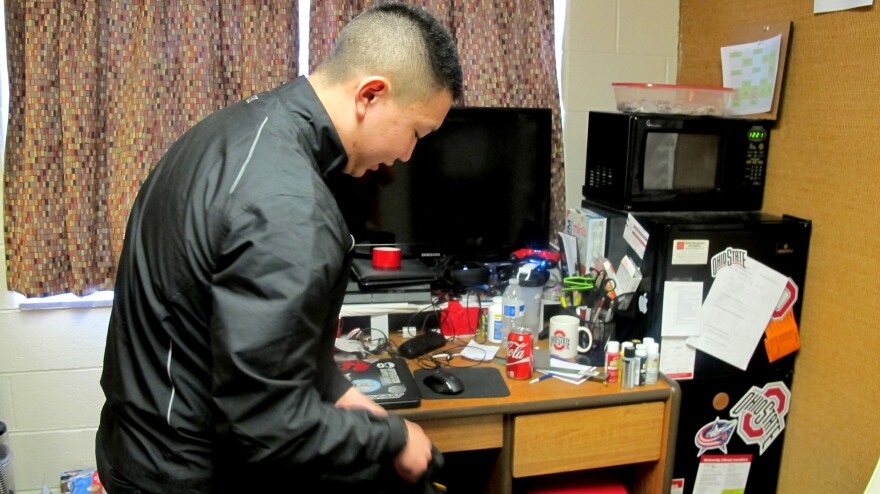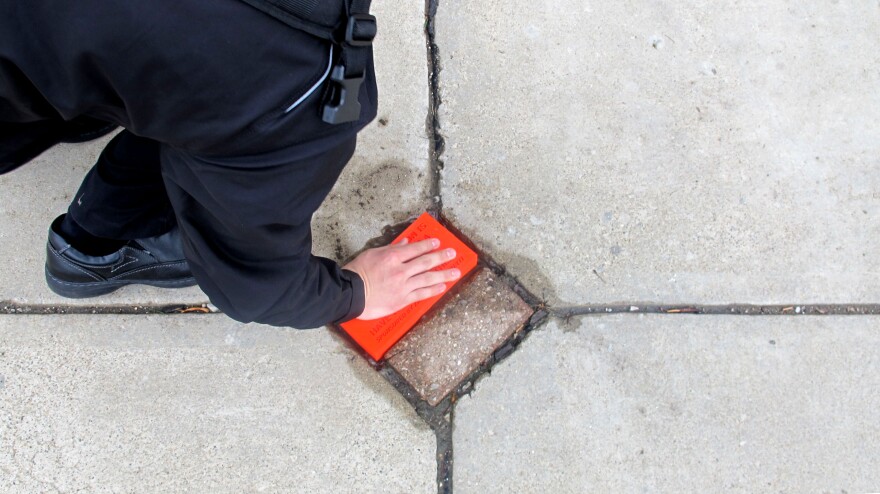In between classes, Ohio State University sophomore Rob Milburn walks around campus looking for places to put bricks.
“I’ve had some spots recommended to me,” Milburn says. “I’m gonna head down the street a little bit, then if I can’t find spots there then I’ll go by the RPAC because there’s always bricks missing there.”
Milburn’s first stop this afternoon is outside Stillman Hall. On the sidewalk, there's an empty spot where a brick should be. He sifts through his backpack, pulls out a bright red plastic brick and wedges it into the ground.
“This one’s not a perfect fit, but it fits in the spot," he says. "I’ll be lucky if it lasts until the end of the day.”
Before even a half hour passes, the brick is gone.
Brickless House
What started as a joke among a few friends is now a crowdfunded project and a source of both acclaim and concern.
For Milburn, who calls himself the "Buckeye Mason," filling missing bricks on campus is a fulltime hobby and something of a public service.
“It just kind of bugs me that in the middle of the sidewalk there’s a brick missing,” Milburn says. “I’m like, just humorously I was talking to my friends and I was like, ‘I got an idea. I should just 3-D print a brick and put it in there.”
So he did.

“Originally I was just gonna print a solid block," Milburn says. "But then I was like, ‘Well, if I’m gonna put it there I might as well have it say something.’ So I put on a little 404 error.”
Like the 404 error one might find if they land on a broken webpage - except this one says "404 BRICK NOT FOUND."
“I did the first one, and then later in the day some of my friends called me and they were like, ‘Hey, have you checked this out? It’s all over Reddit.’ I’m like, ‘Oh wow!’”
On Reddit, a picture of Milburn’s first brick received thousands of views and hundreds of comments. That was just over a week ago - by now, he's printed around 15 bricks and placed them all around campus.

"What's Red And Bad For Your Teeth?"
Since he's only a part-time mason, Milburn's workshop - namely, his 3-D printer - is in his dorm room.
“If you think of a hot glue gun, it’s sort of like that," Milburn explains. "So it’s like taking a spool, sort of a threadlike plastic, and then melting it down and then laying it slowly across into a general outline and the filling of what the brick’s gonna be.”
A timelapse video of a brick being produced, recorded by Milburn for WOSU, shows the arm of the printer stringing the plastic across the brick, back and forth, until it slowly seems to raise off the surface. (This one he branded with "WOSU" on it.)
If the point is filling gaps, it's not a quick fix: The printing process takes between 6-16 hours, depending on the intricacy of the design.
One brick by the North Recreation Center says "Brick Now Loading Please Wait." There's a punny grey brick that boasts, "Printed by: R. Milburn, Installed by: A. Mason." Another asked, simply, "What's red and bad for your teeth?"

Milburn has installed references to Pink Floyd and Rick Astley, but now he's branching out - but still keeping them brick-related if possible.
“I’m kind of running out of brick jokes, so this, today I’ve gone with more inspirational quotes," Milburn says. "So this one’s like, 'A successful person is one who can build a solid foundation on the bricks thrown at them.' Then I’ve got a Steve Jobs quote, and a couple other sort of positive quotes.”
Once the brick is ready, Milburn steps on it to make sure the bottom doesn’t deform under pressure. After all, it's supposed to solve tripping hazards, not create them.
“It’s a good check to make sure it’s structurally sound and people can walk on it," he says.
Once Milburn knows the brick is good to go, he’s ready to place it on campus.
Goodbye Plastic Brick Road
Milburn walks to the Thompson Library, where his project first gained online traction.
Now, the spots where there once were missing bricks have been cemented over by the university.

“See all of these covered here in sand? Those were empty bricks," he says. "Then down here a bit too, about 20 to 30. Some spots on campus it’s like there’s a brick missing here or there. But I don’t know, down here it’s giant groupings of bricks."
Ohio State's facilities department declined to interview, but says they are aware of the brick situation.
Dan Hedman, from the Office of Administration and Planning, offered just this statement: "When bricks go missing it creates extra work for facilities and a safety issue until they are replaced."
“It’s good in the aspect that they’re fixing problems around campus, but it’s kind of bittersweet because it’s like, well, that’s one less spot I can put a brick," Milburn says.
Around campus, though, there are plenty of spaces that still need to be filled.

In his project's infancy, Milburn paid for the printing filament out of his own wallet - about $3 per brick. But as he gained traction on the Ohio State subreddit, he realized the project was going to get expensive.
Then someone on the site suggested he created a crowdfunding page so students could support the effort.
“With the Go Fund Me, I was able to raise enough funds that I’ll have plenty of money to keep this up until the rest of the semester, once that wears out,” Milburn says. “And I’ll probably have enough filament left over after summer to keep going for the next school year.”
Which is good, since people keep stealing his bricks. Pretty quickly into his project, Milburn found his replacement bricks would themselves disappear before the end of day. Now he considers that part of the fun.
Milburn set up a program where you can sponsor a single brick for $5 - or even give $1,000 for the cost of a second 3D printer. So far he's raised over $350, and purchased a whole stack of printing filament.
“As long as I still have ideas for bricks, and as long as there’s still a need to do it, I’ll keep doing it.”





